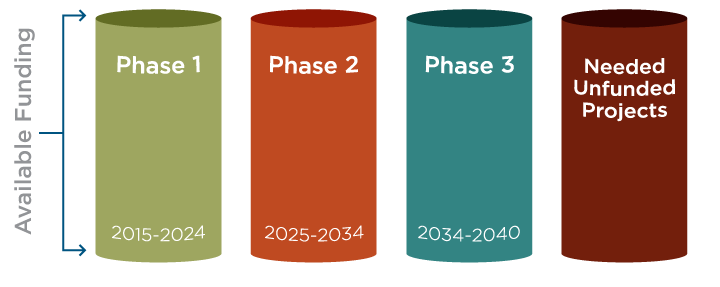Identify phasing for projects in the preferred scenario based on needs and financial constraints.
Revenues used to build and maintain transportation infrastructure come from a variety of sources such as user fees, sales tax, state general fund, fuel taxes, and federal funding. These revenues are received annually and transportation projects can only be built as these funds become available. Therefore, all roadway and transit projects in the Regional Transportation Plan (RTP) must be selected and phased based on need and financial constraints. A project is considered ‘phased’ in the 2015-2040 RTP when the construction start date falls within one of the three phases listed below. As there are more project costs than revenue, some projects are placed into an “unfunded” category. For additional information regarding the financial model used to determine funding availability, visit the “Assess Financial Considerations” page.
- Phase 1: 2015 to 2024
- Phase 2: 2025 to 2034
- Phase 3: 2035 to 2040
- Needed, but not assumed to be funded by 2040
The phasing criteria and methodology used to select projects and the phase of projects differs slightly by mode. Non-motorized facilities were not refined, ranked, or phased because a constrained funding source for these projects has yet to be identified.


For additional information regarding the RTP, please contact Jory Johner.
WFRC used the following criteria to guide the placement of projects into one of three phases. Projects are measured against the criteria below, based on the mode of transportation, and scored on a scale from one to 100.
Roadway Phasing Critieria
| Criterion | Possible Points | Detail |
|---|---|---|
| Travel Time Reduction | 25 | Reduced vehicle hours of delay from traffic congestion. |
| Access to Opportunity | 10 | Access to low income households, multiple-family dwelling units, and/or zero car households is improved and connections to major medical facilities and education centers are improved. |
| Urban Farm | 10 | Supports the Wasatch Choice for 2040 Vision and revitalizes the economy. |
| Multi-modal | 10 | Multiple modes of transportation are considered and coordinated. |
| Project Readiness | 10 | Ready to proceed immediately. |
| Benefit/Cost Ratio | 15 | Considers cost effectiveness of benefits versus total project cost. |
| Safety | 10 | Mitigates safety issues. |
| Asset Management | 5 | Mitigates deficient bridges. |
| Freight | 5 | Enhances freight centers and connections. |
Transit Phasing Critieria
| Criterion | Possible Points | Detail |
|---|---|---|
| Ridership | 20 | Increases ridership volume and frequency of service. |
| Air Quality | 10 | Eliminates vehicle cold starts. |
| Community Center Support | 10 | Serves significant activity centers. |
| Linking Disadvantaged Communities and Opportunities | 10 | Serves disadvantaged neighborhoods and links to economic and health opportunity centers. |
| Transit User Congestion Avoidance | 5 | Congestion delay avoided by transit users. |
| Project Area Complete Streets | 5 | Improves connectivity to bike facilities and municipal support for first/last mile efforts. |
| Benefit/Cost | 30 | Best use of scarce resources, comparing benefits to project cost. |
| Project Readiness | 10 | Considers the readiness of the city for the project, completeness of plans and preservation of the needed property. |


